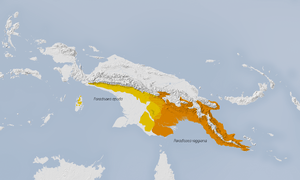Greater bird-of-paradise facts for kids
Quick facts for kids Greater bird-of-paradise |
|
|---|---|
 |
|
| Male | |
| Conservation status | |
| Scientific classification | |
| Genus: |
Paradisaea
|
| Species: |
apoda
|
 |
|
| Paradisaea apoda Paradisaea raggiana | |
The greater bird-of-paradise (Paradisaea apoda) is a stunning bird found in the rainforests. It belongs to a group of birds known for their amazing colors and dances. These birds are part of the Paradisaea genus.
A famous scientist named Carl Linnaeus gave this bird its scientific name, Paradisaea apoda. This name means "legless bird-of-paradise." Long ago, when these birds were first traded to Europe, their wings and feet were often removed. This led to a cool story! People believed these beautiful birds never touched the ground. They thought the birds floated in the air, only landing when they died. Sadly, these birds were hunted for their beautiful feathers.
Contents
About the Greater Bird-of-Paradise
The greater bird-of-paradise is the biggest bird in its group. Males can grow up to 43 cm (17 in) long. This measurement does not include their very long tail feathers. Females are a bit smaller, reaching about 35 cm (14 in).
What Males Look Like
Male greater birds-of-paradise have very special feathers. Their face shines with an iridescent green color. Their crown, head, and the back of their neck are yellow with a silvery shine. The rest of their body is a rich maroon-brown color.
The males also have amazing flank plumes. These are long feathers on their sides. They use these plumes during their mating dances. These feathers are yellow at the bottom and turn white, with maroon streaks.
What Females Look Like
Female greater birds-of-paradise look different from the males. They have plain maroon-brown feathers. Their feathers do not have any stripes or patterns.
Both male and female birds have yellow eyes. Their beaks are a pretty blue color.
Images for kids
See also
 Learn more in Spanish: Ave del paraíso esmeralda grande para niños
Learn more in Spanish: Ave del paraíso esmeralda grande para niños



